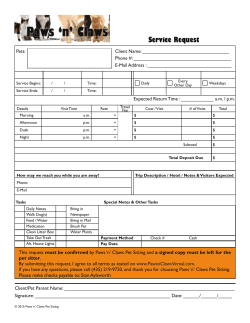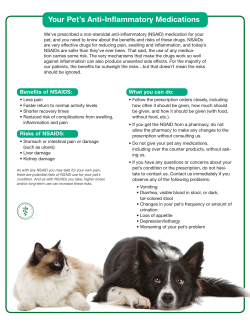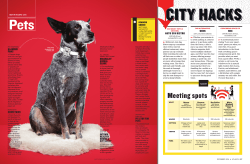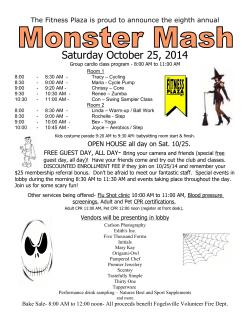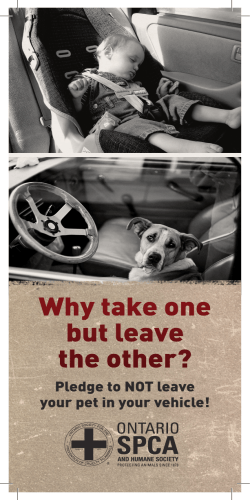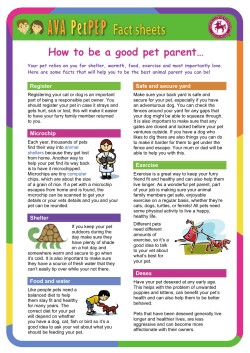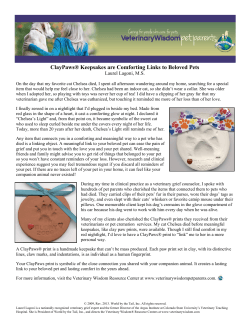
Background and Purpose - the American Pet Products Association
BACKGROUND AND PURPOSE Background and Purpose xv BACKGROUND AND PURPOSE APPA National Pet Owners Survey APPA’S NATIONAL PET OWNERS SURVEY BACKGROUND AND PURPOSE The American Pet Products Association (APPA) was established to promote, develop and advance responsible pet ownership and the pet products industry. To this end, APPA supports industry-related market research, monitors and responds to industry legislation and regulation, and sponsors educational seminars, networking and PR opportunities, giving members the tools they need to make important business decisions. APPA also works closely with other major organizations dedicated to similar goals to accomplish these and other important objectives. In 1988, APPA began gathering information about pet ownership, pet care practices, purchasing behavior of petrelated products and sources of pet-related goods and services. A similar study has been conducted every other year since 1988. The current study was conducted in 2014 and is the fourteenth in the series. APPA’s objective is to monitor consumer habits on an ongoing basis to identify short- and long-term trends, as well as new opportunities in pet ownership and pet product and service consumption. In order to maximize the full value of the report, it is recommended that all readers go beyond the Executive Summary and thoroughly read each of the species sections. METHODOLOGY AND SAMPLE The 2015-2016 National Pet Owners Survey was conducted by Ipsos, Inc. Invitations to the current Survey were distributed online to a nationally representative sample from the Ipsos Online Panel. The Survey was divided into two parts–a screener and detailed pet owner module (questionnaire). 25,088 respondents completed the screener, of which 16,175 were current pet owners. Following the screener, there were eight different modules (questionnaires), each corresponding to a different type of pet–dog, cat, bird, small animal, reptile, freshwater fish, saltwater fish and horse. Upon completing the screener, pet owners selected for one of the eight follow-up modules (questionnaires) were then directed to complete the appropriate module (questionnaire) based on the type of pet they own. A total of 2,581 completed pet owner surveys are included in the tabulations. The table below shows the number of completed surveys for each pet type. Pet Type Dog Cat Completed Surveys 521 457 Freshwater Fish Saltwater Fish Bird 302 150 301 Small Animal Reptile Horse 300 300 250 The online sample was balanced by gender, age, household size, income and region (a map showing the states that comprise each region may be found at the end of this section). Ipsos has over 25 years of experience in online panel management and online respondent access combined with the most advanced sampling methods and technologies in this field. They have one of the largest online panels in the world, with the U.S. online panel alone consisting of approximately 650,000 individuals. QUESTIONNAIRE REVISIONS As in previous years, a questionnaire revision process was conducted for the 2015-2016 Survey. Given the 2012 methodological shift to conducting the research online, considerable effort was made to maintain consistency across the questionnaires wherever possible. For those questions that changed, the changes are noted within each report section. Copies of the questionnaires for each pet type can be found at the end of each species section of this report. (Please note that the questionnaires appear in text-only format and not as they would be seen in an actual online survey.) xvi APPA National Pet Owners Survey BACKGROUND AND PURPOSE 2012 CHANGE IN METHODOLOGY APPA has been one of the primary providers of information on consumer behavior in the pet market for over 20 years. In 2012, the National Pet Owners Survey was conducted online for the first time. This was a deliberately planned and carefully tested shift in methodology designed to update the Survey to reflect current trends in conducting consumer research. Online research reaches the majority of the population and remains nationally representative. At the same time, it also streamlines the study process by combining the screening and pet owner follow-up into one survey, which means the study is conducted over weeks instead of months. This ultimately provides the reader with more current and actionable pet owner data. With any change in methodology, there will be differences between the old and new data. The shift in methodology necessitated no direct comparisons between data collected online and data collected via the mail. This is also noted in the data tables by a thick solid line between the data for 2010 and 2012. In the case of questions that remained the same, some data from previous years are included as a historical benchmark. Across the board, the individual species data has remained very consistent across the past few Surveys. This is an extremely important point to note; that while the absolute values may change, the consumer preferences and resulting business decisions are the same. MARGIN OF ERROR The margin of error is based on the rate of response for each questionnaire version. It should be used only for binomial or yes/no responses. These margins cannot be used for questions with means, as they have a confidence interval, which depends upon both the variance and sample size. Within the report, the percentages shown might vary by the margins (or number of percentage points) noted below if all pet owners in the U.S. were interviewed. Pet Type Dog Cat Freshwater Fish Saltwater Fish Bird Small Animal Reptile Horse Margin of error j +/- 4.3% +/- 4.6% +/- 5.7% +/- 8.1% +/- 5.7% +/- 5.7% +/- 5.7% +/- 6.2% j Plus or minus number of percentage points. FOOTNOTES Several footnotes appear at the bottom of certain tables and pages. An asterisk (*) denotes that the percent is less than 0.5%. Certain columns will add up to more than 100% due to multiple responses. “No Answer” will not be shown in data tables because it is no longer applicable for online surveys. Respondents must choose an answer for all questions. All of the tables start at the earliest year (where possible to include) with the most recent data being shown last (the last column on the right). The 2015-2016 Survey data is reported as 2014 (the year the data was collected). In order to maintain comparability and to allow comparisons across the species, the data in common questions are not rank ordered. When no percent is noted on a graph/chart, the percent was “0.” The “0” percent was deleted to make the graph/ chart easier to read. CUSTOM REPORTS Additional proprietary custom reports are available based on the 2015-2016 Survey. Please call APPA’s Member Relations department for information about the types of reports that are available. xvii BACKGROUND AND PURPOSE APPA National Pet Owners Survey GENERATION DATA A new analysis of the data was conducted to determine the relationship between pet ownership and respondent age group (or generation). Therefore, tables with the heading “Generation” employ the following definitions for each: “Gen Y” (1980-1994) includes all respondents aged 18-33; “Gen X” (1965-1979) respondents are 34-48 years old; “Baby Boomers” (1946-1964) are between 49-67; and “Builders” (1925-1945) are 68+ years old. PREVIOUS AND NON-PET OWNERS APPA publishes a separate report titled the APPA National Pet Market Opportunity Study that addresses previous and non-pet ownership. Data including demographics, psychographics and reasons for not currently owning a pet are examined in-depth. Volume 1 was released in 2014 and is available for purchase. Please go online to www. americanpetproducts.org or call APPA’s Member Relations department for more information. DEMOGRAPHICS At the end of each species section there are demographic tables. The first column reports the demographics of the Total U.S. Sample which includes all of the panelists who returned a questionnaire (25,088). These 25,088 questionnaires include both pet owners and non pet owners in order to have a balanced sample of the U.S. population. These demographics were then used as a benchmark to which specific pet owner demographics were compared. The demographic tables include and compare the demographics of the Total U.S. Sample to the Total U.S. Pet Owning Population, as well as to all species-specific pet owners in the U.S. STORE TYPE DEFINITIONS To help answer certain questions, this list was included in each questionnaire to ensure a common understanding of the definition of each store type. TYPE OF STORE EXAMPLES Discount Store/Mass Merchandiser . . . . . . . . . . . . . . . Fred Meyer, Kmart, Meijers, Target, Wal-Mart Feed Store/Agricultural Supplies . . . . . . . . . . . . . . . . . . . Agway, Mill’s Feed Grocery Store . . . . . . . . . . . . . . . A&P, Food Lion, Kroger, Safeway, Super Valu, Stop N’ Shop, Von’s, Winn-Dixie Home Improvement/ Hardware/Garden Store . . . . . . . Ace, Home Depot, Lowes, Pergament, Servistar, Southern States Co-op, True Value Internet/Online. . . . . . . . . . . . . . PETsMART.com, PETCO.com, Walmart.com Mail Order Catalog. . . . . . . . . . . Foster & Smith, J.B. Pet Supplies, New England Serum, Omaha Vaccine, R.C. Steele Pet Chain/Superstore. . . . . . . . . . PETCO, PETsMART, Pet Supermarket, Pet Supplies Plus, Petland Discount Pet Store - Independent. . . . . . . . A locally-owned, independent store selling pets and/or pet supplies Other. . . . . . . . . . . . . . . . . . . . . Any outlet type not named above xviii APPA National Pet Owners Survey BACKGROUND AND PURPOSE Pacific Mountain West North West South East North Central Central Central East South Central South Atlantic Mid Atlantic New England California Arizona Iowa Arkansas Illinois Alabama New York Connecticut Oregon Colorado Kansas Louisiana Indiana Kentucky District of Columbia New Jersey Maine Washington Idaho Montana Minnesota Missouri New Mexico North Dakota Nevada Nebraska Utah South Dakota Wyoming Oklahoma Texas Michigan Ohio Wisconsin Mississippi Tennessee Delaware Florida Pennsylvania Massachusetts Georgia New Hampshire Maryland Rhode Island North Carolina Vermont South Carolina Virginia West Virginia xix
© Copyright 2025
